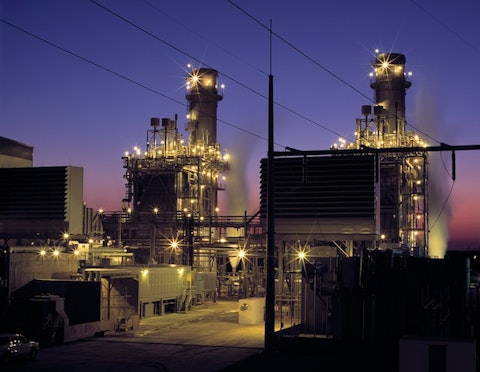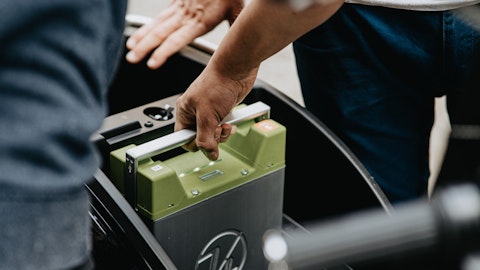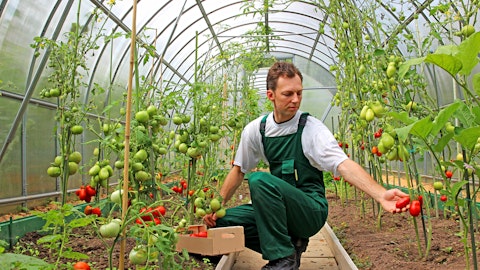FMC Corporation (NYSE:FMC) Q4 2022 Earnings Call Transcript February 8, 2023
Operator: Good morning, and welcome to the Fourth Quarter 2022 Earnings Call for FMC Corporation. This event is being recorded and all participants are in listen-only mode. . I would now like to turn the conference over to Mr. Zack Zaki, Director of Investor Relations for FMC Corporation. Please go ahead.
Zack Zaki: Thank you, Emily, and good morning, everyone. Welcome to FMC Corporation’s fourth quarter earnings call. Joining me today are Mark Douglas, President and Chief Executive Officer; and Andrew Sandifer, Executive Vice President and Chief Financial Officer. Mark will review our fourth quarter and full year performance as well as provide an outlook for full year 2023 and the first quarter. Andrew will provide an overview of select financial results. Following the prepared remarks, we will take questions. Our earnings release and today’s slide presentation are available on our website, and the prepared remarks from today’s discussion will be made available after the call. Let me remind you that today’s presentation and discussion will include forward-looking statements that are subject to various risks and uncertainties concerning specific factors, including, but not limited to, those factors identified in our earnings release and in our filings with the Securities and Exchange Commission.
Information presented represents our best judgment based on today’s understanding. Actual results may vary based upon these risks and uncertainties. Today’s discussion and the supporting materials will include references to adjusted EPS, adjusted EBITDA, adjusted cash from operations, free cash flow, net debt and organic revenue growth, all of which are non-GAAP financial measures. Please note that as used in today’s discussion, earnings means adjusted earnings and EBITDA means adjusted EBITDA. A reconciliation and definition of these terms as well as other non-GAAP financial terms to which we may refer during today’s conference call are provided on our website. With that, I will now turn the call over to Mark.
Mark Douglas: Thank you, Zack, and good morning, everyone. FMC delivered record performance in the quarter, driven by a combination of robust volume growth and strong pricing actions. Sales of new products continue to accelerate nearly doubling year-over-year and representing 11% of the total sales in the quarter. We continue to make investments in expanding our market access in key geographies, including the U.S. and Brazil. Pricing actions in the quarter more than offset headwinds from both cost and FX, resulting in EBITDA margin expansion in excess of 40 basis points. This positive gap between price gains and headwinds from cost and FX and is expected to continue as we move forward through 2023. Agricultural markets remain robust with high commodity prices, increasing acreage for crops and positive grower sentiment, providing a solid backdrop for FMC.
Our Q4 results are detailed on Slides 3, 4 and 5. Revenue was up 17% organically, EBITDA up 17% and EPS up 12%. The U. S. and Brazil were major contributors to the quarter’s results, with volume and price driving the U.S. business, while price and FX drove Brazil’s results. Adjusted earnings were $2.37 per diluted share in the quarter, $0. 07 above the midpoint of our guidance range. With this outperformance driven by higher EBITDA and lower-than-anticipated taxes. In North America, sales increased 35% year-over-year, driven by strong sentiment among growers and our distribution partners in the U.S. for the upcoming season. Selected herbicides for soybeans and other crops as well as fungicides for corn grew rapidly in the quarter. We have made great progress in revitalizing our North American product portfolio with almost 20% of the quarter’s branded sales coming from products launched in the last 5 years.
We have also invested in more sales and tech service resources, enabling us to reach more retailers to promote our newest technologies and expand our market access. In Latin America, sales increased 13% year-over-year and 9% organically, led by Brazil. Pricing actions, demand for our fungicides and selective herbicides as well as our investments in market access drove results for the region. Our market access investments contributed to about 50% of the region’s growth in the quarter. FX was also a benefit in the quarter, driven by the strong BRL. However, dry weather negatively impacted corn and soy in Southern Brazil and Argentina. Asia was flat versus the fourth quarter last year and up 12% organically. Insecticides and selective herbicides led the growth in the region.
Overwatch herbicide, which is based on Isoflex, the first active from our pipeline, continues to gain share on cereals in Australia. Almost 20% of branded sales in Asia came from products launched in the last 5 years. FX was a significant headwind in the quarter, offsetting the double-digit organic growth. EMEA was up 7% versus prior year and up 20% organically. In addition to strong pricing, results were driven by broad-based demand, especially for cereal herbicides. 13% of branded sales in the quarter came from products launched in the last 5 years and sales of formulations almost doubled in the quarter. In our Plant Health business, Biologicals grew double digits in the quarter, reflecting the strength of our portfolio. Overall, adjusted EBITDA for the fourth quarter was $432 million, an increase of 17% compared to the prior year period, resulting in EBITDA margin expansion in excess of 40 basis points.
Average price increases of 8% contributed $109 million in the quarter and more than offset the cost and FX headwinds. Moving to Slide 6 in FMC’s full year 2022 results. We reported record $5.8 billion in revenue which reflects a 15% increase on a reported basis and 18% organic growth. This is despite exiting our Russian business earlier in the year. More than $600 million in sales came from products launched in the last 5 years, growth of 50% over the previous year and about $100 million came from products launched in 2022, continuing the multiyear trend of strong growth from new technologies. Diamides grew in the mid- to high single-digit range for the year. Adjusted EBITDA was $1.407 billion, an increase of 7% compared to 2021, despite $463 million in cost headwinds and $74 million in FX headwinds.
Exiting Russia negatively impacted our EBITDA by approximately $25 million. The benefit from pricing actions in the year was $372 million. This was necessary to overcome the most significant input cost headwinds we have ever experienced. We believe input cost headwinds peaked in the third quarter and expect them to ease going forward. 2022 adjusted earnings were $7.41 per diluted share, an increase of 8% versus 2021. This increase was driven primarily by the EBITDA increase and lower share count, offset partially by higher interest expenses and taxes. In addition to these financial results, we also had other significant achievements in the year as detailed on Slides 7 and 8. FMC continues to make substantial progress on our sustainability and net zero goals.
For example, we reduced Scope 1 and 2 greenhouse gas emissions at our operating sites by at least 2% in the last year, while at the same time, delivering record growth. The consistent progress we have made on various ESG metrics was recognized by several raters that moved us up on their rankings in 2022. FMC now stands at or above industry average across these raters. In our Plant Health business, we launched 17 new biological products spread across all 4 regions as well as 2 new micronutrient products. We also acquired BioPhero in 2022. As we’ve said before, BioPhero is a pioneer in biologically produced pheromone technology with a patented fermentation platform that enables significantly lower cost production compared to current standards.
In Precision Ag, we continue to advance our Arc Farm Intelligence platform, FMC’s proprietary mobile solution that helps farmers manage pest pressure through predictive modeling. Arc is now deployed across 20 million acres spanning over 20 countries, and we have found the growers who use Arc are tending to buy a broader range of products from FMC. Finally, our venture capital arm, FMC Ventures continued to build its portfolio in 2022 with new collaborations and strategic investments in start-ups and early-stage companies, working on new or disruptive technologies. These engagements, which support or augment our internal capabilities span several technology segments, including robotics, drone technology, ag fintech, pathology detection, soil health, peptides and pheromone.
As an example, in 2022, FMC Ventures increased its investment in Micropep, the start of developing short natural peptide molecules that target and regulate plant genes and proteins. In addition to our equity investment, we entered into a strategic collaboration with Micropep late last year to develop solutions to control herbicide-resistant weeds. FMC Ventures also invested in Traive, an ag fintech startup, addressing working capital needs of growers in Brazil. Turning to Slide 9, which provides the key market and cost dynamics underpinning our 2023 outlook. We expect crop commodity prices to remain robust and that growers around the world will continue to rely on our advanced technologies to deliver high yields while they combat erratic weather patterns.
We expect the North American market to grow in the low single-digit range with an assumption of normal weather conditions. The Latin American market is believed to have grown significantly in 2022 primarily due to rapidly price increases in nonselective herbicides, a product segment in which FMC does not participate. In 2023, we expect the Latin American market to contract by mid-single digits as some of those gains in nonselective herbicides reverse. Asian markets are expected to be flat to last year. And EMEA is expected to be up high single digits with improvements driven by increasing acres for cereals. Taking into account these regional market projections and in light of the very strong market growth in 2022, we expect the overall crop protection market will grow this year in the low single-digit range on a U.S. dollar basis.
FMC’s continued pricing actions, strong demand for our product portfolio, particularly our newest technologies as well as further market access gains are expected to provide solid support for FMC’s top line to grow above the market rates. Costs are anticipated to remain a year-over-year headwind throughout the year. However, we aren’t seeing deceleration of input cost inflation and these costs are expected to become a year-over-year tailwind in the second half. We will continue to invest in R&D and SG&A to expand market access, grow our Plant Health business, deploy new technologies through Precision Ag and develop new synthetic and biological products. Overall, we expect price increases to more than offset cost and FX headwinds, resulting in margin expansion in the second half of the year.

Photo by American Public Power Association on Unsplash
Turning to Slide 10 for our full year 2023 outlook. We expect the full year revenue in the range of $6.08 billion to $6.22 billion representing a 6% growth at the midpoint compared to 2022. New launches and market access initiatives will drive volume growth with mid-single-digit pricing expected for the full year. FX is expected to be a moderate headwind to top line results. Adjusted EBITDA is forecasted to be in the range of $1. 48 billion to $1.56 billion, reflecting 8% year-over-year growth at the midpoint. Price is anticipated to be the primary driver of EBITDA growth in the year, with cost headwinds expected to be significantly lower than those experienced last year. Increases in the input cost portion of cost headwinds are anticipated to decelerate as the year progresses and become a year-over-year tailwind in the second half.
We expect adjusted earnings of $7.20 to $8 per diluted share, representing a 3% increase at the midpoint, with EPS growth limited by higher interest and tax rates. This assumes a share count of approximately 126.5 million and does not factor in the benefit of any potential share repurchases in the year. Looking at the first quarter outlook on Slide 10, we forecast revenue to be in the range of $1.41 billion to $1.45 billion, representing 6% growth at the midpoint compared to the first quarter of 2022. We are targeting mid- to high single-digit price increases of which much has already been implemented. Price is expected to be the primary driver of revenue growth in the quarter. FX is anticipated to be a headwind in the quarter. Adjusted EBITDA is forecasted to be in the range of $345 million to $365 million, flat versus the prior year period at the midpoint, mainly due to pricing gains being offset by expected cost headwinds.
Volume gains are expected to be offset by FX-related headwinds. We expect adjusted earnings per diluted share to be in the range of $1.63 to $1.83, representing a decrease of 8% at the midpoint due to higher interest rates and taxes. This assumes a share count of approximately 126.5 million. Moving now to Slide 12. I want to highlight some of the potential factors that could drive our results to either end of the guidance range. For the midpoint of our adjusted EBITDA guidance, we are assuming market growth in the low single-digit range and FMC achieving mid-single-digit price increases. Input cost headwinds are expected to continue decelerating and become a tailwind as the year progresses, while FX is expected to be a headwind throughout the year.
With the resilience we’ve built into our supply chain, our base case assumes any minor disruptions are mitigated. Alternatively, if cost headwinds ease more rapidly, if the market grows at a higher rate than forecasted and if we are able to realize high single-digit prices or FX has a lower impact, we could deliver results at the high end of our guidance range. Major supply disruptions of critical inputs or services are examples of factors that would drive results below the midpoint of the guidance range. With that, I’ll now turn the call over to Andrew.
Andrew Sandifer: Thanks, Mark. I’ll start this morning with a review of some key income statement items. FX was a 2% headwind to revenue in the fourth quarter, with weakness in Asian and European currencies, partially offset by strength of the Brazilian real. For full year 2022, FX was a 3% headwind overall, with the most significant headwinds coming from the euro, Turkish lira and Indian rupee, offset in part by a strong Brazilian real. Looking ahead to 2023, we see continued modest FX headwinds on the horizon, consistent with the initial outlook for 2023 we provided on the November call. For the first quarter of 2023, these headwinds are across a range of Asian and European currencies. Interest expense for the fourth quarter was $44.8 million, up $11.8 million versus the prior year period.
Interest expense for full year 2022 was $151.8 million, up $20.7 million versus the prior year. Rising U.S. interest rates were the primary driver of higher interest expense for both the quarter and the full year. Looking ahead to 2023, we expect full year interest expense to be in the range of $200 million to $210 million, an increase of more than $50 million at the midpoint versus 2022, driven primarily by higher U.S. interest rates. Our effective tax rate on adjusted earnings for full year 2022 came in slightly better than anticipated at 13.7%, driven by a modest shift in mix of earnings across principal operating companies. The fourth quarter effective tax rate of 13. 1% reflects the true-up to the full year rate relative to the 14% rate accrued through the third quarter.
For 2023, we estimate that our tax rate should be in the range of 14% to 16% with the increase driven by anticipated higher foreign earnings subject to U. S. GILTI tax versus 2022. Moving next to the balance sheet and liquidity. Gross debt at year-end was slightly below $3.3 billion, down $285 million from the prior quarter. Gross debt to trailing 12-month EBITDA was 2.3x at year-end while net debt-to-EBITDA was 2.0x. On a full year average basis, gross debt-to-EBITDA was 2.6x, while net debt to EBITDA was 2.3x. Moving on to cash flow generation and deployment on Slide 13. FMC generated free cash flow of $514 million in 2022, down 28% versus the prior year. Adjusted cash from operations was down nearly $250 million compared to the prior year.
Growth in EBITDA and cash provided by nonworking capital items were more than offset by cash used by working capital. Receivables net of rebates, vendor financing and advanced payments were a major use of cash driven by the inflationary impact on receivables and price increases to offset cost headwinds. Advanced payments from customers in North America were up somewhat, but grew rate much slower than revenue growth. Inventory was the use of cash with year-end inventory levels higher, as expected, given our anticipation of a strong Northern Hemisphere season in the first half of 2023 and the impact of inflation on inventory values. Accounts payable was a source of cash driven by cost inflation. Capital additions and other investing activities of $119 million were up $5 million compared with the prior year, with nearly half of the spending directed towards capacity expansion.
Legacy and transformation was down substantially with the decrease due entirely to proceeds from the disposition of an inactive site. Legacy and transformation would have been essentially flat year-on-year in the absence of these proceeds. Overall, free cash flow conversion from adjusted earnings for 2022 was 55%, with rolling 3-year average free cash flow conversion at 67%, slightly below our long-term goal for 3-year average cash conversion of 70% or more due to the inflationary impacts on working capital. With this free cash flow and a modest increase in net debt year-on-year, we deployed $566 million in 2022 with nearly $370 million returned to shareholders through $267 million in dividends and $100 million of share repurchases. The remainder of cash deployed in 2022 was used to acquire BioPhero and to make equity investments through FMC Ventures.
With leverage levels through the year, slightly above our targeted ranges, we chose not to repurchase additional shares following our third quarter earnings call. Looking ahead now to free cash flow generation and deployment for 2023 on Slide 14. We are forecasting free cash flow of $530 million to $720 million in 2023, up more than 20% year-on-year at the midpoint. Underlying this forecast is our expectation of adjusted cash from operations of $800 million to $920 million, up $200 million at the midpoint, with the increase driven by growth in EBITDA and slower growth in working capital resulting from lower sales growth and easing input cost inflation. This is partially offset by higher cash interest and taxes. We further expect to continue to modestly ramp up capital additions as we expand capacity to meet growing demand and to support new product introductions.
Legacy and transformation cashment is expected to be essentially flat to midpoint after adjusting for the benefit from the disposal of the inactive site for 2022. With this guidance, we anticipate free cash flow conversion of 65% at the midpoint for 2023, a significant improvement from the 55% conversion last year. The rolling 3-year average free cash flow conversion is expected to be 67% just under our targeted conversion range of 70% or more. With interest rates substantially higher, we do not intend to utilize incremental borrowing capacity for cash deployment this year so as to mitigate the impact of higher interest expense on earnings and cash flow. Free cash flow will be used first to fund the dividend and approximately $290 million use of cash at the newly raised dividend per share authorized by our Board of Directors in December.
Free cash flow will then be used to fund inorganic growth, if attractive opportunities become available. Free cash flow remaining after any such investments will then be directed to share repurchases. Given the seasonal nature of our cash flow, any share repurchases will be weighted more heavily to the latter part of the year. That said, we do intend to repurchase in the first quarter at a minimum, enough FMC shares to offset any dilution from share-based compensation. I must emphasize that this is not a permanent change in capital policy for FMC. Rather, this is temporary as we adjust structurally higher interest rates in the United States. Our intent here is to actively manage the impact of higher rates in 2023. Should interest rates ease, we would consider using incremental debt capacity to expand our cooler deployable cash.
Finally, moving on to Slide 15. Let me put our free cash flow generation and deployment into perspective. Since launching FMC is a focused agricultural sciences company in 2018, we’ve made substantial improvements in free cash flow generation and free cash flow conversion from earnings. As you can see on the left-hand side of this page, we’ve improved 3-year rolling average free cash flow conversion from adjusted earnings from 42% in 2020 to 67% at the midpoint of 2023 guidance. We’ve shown we can convert more than 70% of earnings to cash in a single year, as we did in 2021, and we are well on our way to our targeted 70% or more rolling 3-year average cash conversion. Equally as important, we’ve been very balanced in how we’ve utilized this improved cash flow generation.
Strongly rewarding shareholders with nearly $2 billion in cash returned over 2019 to 2022, split equally between share repurchases and dividends, while fully funding our organic growth, as well as directing $268 million to inorganic growth investments like our recent acquisition of BioPhero. Overall, we feel this approach to cash deployment balances shareholder rewards over both the near and long-term horizon. And with that, I’ll hand the call back to Mark.
Mark Douglas: Thank you, Andrew. FMC delivered a record performance in 2022 despite facing the largest input cost inflation headwinds in the company’s history. Robust volumes driven by our market access initiatives and the continued accelerated growth of new products as well as strong pricing gains helped to overcome significant cost, supply and FX challenges in the year. We expect the broader economy to be volatile in 2023. However, agricultural market fundamentals are expected to remain solid. FMC’s pricing momentum continues, and we should benefit from the potential deflation in the broader industrial supply chains. We continue to invest in our technology portfolio of synthetics, biologicals, precision ag and FMC Ventures.
Our expanding market access initiatives are resulting in increased profitable growth, and we intend to continue the pace of these investments across more countries. Overall, there are fewer disruptive factors that we see today compared to the same time period last year, and this strengthens our confidence in the narrow guidance range we have provided. We expect to deliver another year of strong and profitable growth in 2023. Finally, as we are now in the final year of our current strategic plan, we are planning to host an Investor Day at our global headquarters in Philadelphia this November. At that time, we will share details of our new strategic plan and we look forward to seeing you here in person. We will, of course, announce the date for this Investor Day event soon.
Zack Zaki: Thank you. Emily, you may now take questions.
See also 20 Best For-Profit Colleges in the US and 15 Most Undervalued Small-cap Stocks To Buy.
Q&A Session
Follow Fmc Corp (NYSE:FMC)
Follow Fmc Corp (NYSE:FMC)
Operator: Our first question comes from Christopher Parkinson with Mizuho.
Christopher Parkinson: Great. It does look like you have some cost benefit built into your — just the midpoint of your EBITDA growth versus your projected revenues. I know you’ve been taking a prudent approach on the price cost in terms of the cost side and forecasting. But can you just talk a little bit more on how you see that progressing throughout the year, specifically in the second half and even potentially how you think it progresses throughout the year, which would even have implications on the first half of ’24.
Mark Douglas: Yes. Thanks, Chris. So let me take a step back on that one and just talk a little bit about — I mentioned in the script where we were last year versus where we are this year. Last year at this time, we had a wave coming at as of inflationary costs. And truly, we did not understand the order of magnitude. We ended up with what — $463 million of costs at the beginning of the year, our forecast had nothing like that number. I would say this year, we’re in exactly the reverse position. We see cost receding, we just don’t know exactly how much that will be. We know it will impact us in the second half of the year. And we have built what I would call a modest amount of cost reduction into the midpoint of our guidance.
But what I really see is a time line here that gets us through the end of this year and into early 2024, where costs do become a meaningful tailwind for us. We do expect to see margin expansion as we go through the second half of the year. We did talk about the fact that we will continue to invest in SG&A and R&D, and I’ll have Andrew add a couple of comments here at the end on details here. We are investing in those areas because frankly, we are seeing profitable growth from those investments, whether I think about the growth in Brazil or I think about the growth in the U.S. or other parts of Asia, those investments are paying off very quickly in terms of how we gather new sales from new customers and new parts of the value chain. R&D is growing very simply because we’re investing not only in our synthetic pipeline.
And this year, we moved another molecule from discovery into development, and we’ll talk more about that in Investor Day. But we’ve also got a full year run rate of our BioPhero investment in R&D, and we continue to invest in Plant Health and Precision Ag. So if you think about a growth rate of roughly 6% for the top line, you should expect SG&A to be growing pretty close to the 6%. And then R&D, a little bit above that. That’s how it will flow through the year. The input costs are higher in the first half. And you can see what we said about in Q1, we still have high input costs. They were a legacy of what we bought in the second half of last year. Those will abate as we go through the half, and then in the second half, we’ll get that margin expansion.




